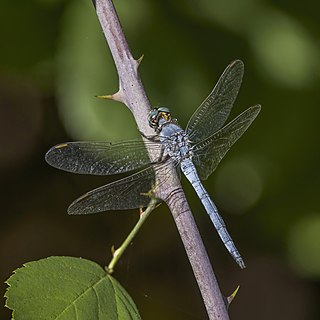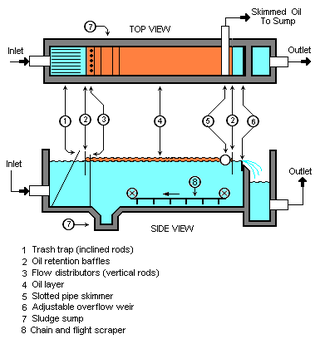Skimmer may refer to:
Skimmer may refer to:
Filtration is a physical process that separates solid matter and fluid from a mixture.

A dragonfly is a flying insect belonging to the infraorder Anisoptera below the order Odonata. About 3,000 extant species of dragonflies are known. Most are tropical, with fewer species in temperate regions. Loss of wetland habitat threatens dragonfly populations around the world. Adult dragonflies are characterized by a pair of large, multifaceted, compound eyes, two pairs of strong, transparent wings, sometimes with coloured patches, and an elongated body. Many dragonflies have brilliant iridescent or metallic colours produced by structural coloration, making them conspicuous in flight. An adult dragonfly's compound eyes have nearly 24,000 ommatidia each.

The skimmers, forming the genus Rynchops, are tern-like birds in the family Laridae. The genus comprises three species found in South Asia, Africa, and the Americas. They were formerly known as the scissorbills.

Cutting fluid is a type of coolant and lubricant designed specifically for metalworking processes, such as machining and stamping. There are various kinds of cutting fluids, which include oils, oil-water emulsions, pastes, gels, aerosols (mists), and air or other gases. Cutting fluids are made from petroleum distillates, animal fats, plant oils, water and air, or other raw ingredients. Depending on context and on which type of cutting fluid is being considered, it may be referred to as cutting fluid, cutting oil, cutting compound, coolant, or lubricant.

The black-tailed skimmer is a dragonfly belonging to the family Libellulidae.

The common whitetail or long-tailed skimmer is a common dragonfly across much of North America, with a striking and unusual appearance. The male's chunky white body, combined with the brownish-black bands on its otherwise translucent wings, give it a checkered look. Females have a brown body and a different pattern of wing spots, closely resembling that of female Libellula pulchella, the twelve-spotted skimmer. Whitetail females can be distinguished by their smaller size, shorter bodies, and white zigzag abdominal stripes; the abdominal stripes of L. puchella are straight and yellow.

A protein skimmer or foam fractionator is a device used to remove organic compounds such as food and waste particles from water. It is most commonly used in commercial applications like municipal water treatment facilities, public aquariums, and aquaculture facilities. Smaller protein skimmers are also used for filtration of home saltwater aquariums and even freshwater aquariums and ponds.

Libellula quadrimaculata, known in Europe as the four-spotted chaser and in North America as the four-spotted skimmer, is a dragonfly of the family Libellulidae found widely throughout Europe, Asia, and North America.

The keeled skimmer is a species of dragonfly belonging to the family Libellulidae.
Dissolved air flotation (DAF) is a water treatment process that clarifies wastewaters by the removal of suspended matter such as oil or solids. The removal is achieved by dissolving air in the water or wastewater under pressure and then releasing the air at atmospheric pressure in a flotation tank basin. The released air forms tiny bubbles which adhere to the suspended matter causing the suspended matter to float to the surface of the water where it may then be removed by a skimming device.
Skim or skimming may refer to:

The flame skimmer or firecracker skimmer is a common dragonfly of the family Libellulidae, native to western North America.

The River Glaven in the eastern English county of Norfolk is 10.5 mi (16.9 km) long and flows through picturesque North Norfolk countryside to the North Sea. Rising from a tiny headwater in Bodham the river starts 2+1⁄2 miles before Selbrigg Pond where three small streams combine. The scenic value of the Glaven valley is important to the tourist industry in North Norfolk. The river is one of over 200 chalk rivers in the world and one of 160 in the UK.
An oil skimmer is a device that is designed to remove oil floating on a liquid surface from oil spills. The effectiveness of a skimmer is highly dependent on the roughness of the surrounding water that it is working on: the more choppy the surrounding wake and water, the more water the oil skimmer will take in along with the oil, rather than take in oil alone. Skimmers can be self-propelled, used from shore, or operated from vessels, with the best choice being dependent on the specifics for the job at hand. Skimmers can be pressed into use for a number of applications other than oil spills, with the correct type to use again being dependent on the nature of the intended application. Examples of possible uses include making skimmers one component of oily water treatment systems, removing oil from machine tool coolant and aqueous parts washers, and collecting fats, oils, and greases as part of wastewater treatment efforts for food manufacturing industries.

Swimming pool sanitation is the process of ensuring healthy conditions in swimming pools. Proper sanitation is needed to maintain the visual clarity of water and to prevent the transmission of infectious waterborne diseases.

An API oil–water separator is a device designed to separate gross amounts of oil and suspended solids from industrial wastewater produced at oil refineries, petrochemical plants, chemical plants, natural gas processing plants and other industrial oily water sources. The API separator is a gravity separation device designed by using Stokes Law to define the rise velocity of oil droplets based on their density and size. The design is based on the specific gravity difference between the oil and the wastewater because that difference is much smaller than the specific gravity difference between the suspended solids and water. The suspended solids settles to the bottom of the separator as a sediment layer, the oil rises to top of the separator and the cleansed wastewater is the middle layer between the oil layer and the solids.

A spider is a type of skimmer prevalent in East Asian cuisine in the form of a wide shallow wire-mesh basket with a long handle, used for removing hot food from a liquid or skimming foam off when making broths. The name is derived from the wire pattern, which looks like a spider's web. It has been widely adopted in Western cuisine by cooks who favour the open mesh over slotted spoons for faster and safer drainage.
Induced gas flotation (IGF) is a water treatment process that clarifies wastewaters by the removal of suspended matter such as oil or solids. The removal is achieved by injecting gas bubbles into the water or wastewater in a flotation tank or basin. The small bubbles adhere to the suspended matter causing the suspended matter to float to the surface of the water where it may then be removed by a skimming device.
Groundwater remediation is the process that is used to treat polluted groundwater by removing the pollutants or converting them into harmless products. Groundwater is water present below the ground surface that saturates the pore space in the subsurface. Globally, between 25 per cent and 40 per cent of the world's drinking water is drawn from boreholes and dug wells. Groundwater is also used by farmers to irrigate crops and by industries to produce everyday goods. Most groundwater is clean, but groundwater can become polluted, or contaminated as a result of human activities or as a result of natural conditions.

A skimmer or surface separator is an essential accessory for the maintenance and cleaning of the water in a swimming pool. It is used to remove all the surface dirt floating on the water surface, such as leaves, tanning oil and human secretions. These impurities remain suspended on the surface, affect the appearance of the water and are not always removed by the conventional vacuuming process. The skimmer is installed directly in the surface water suction system and also has the function of controlling the water level to prevent accidental overflows. In the United States and Portugal, the use of skimmers in the construction of swimming pools is mandatory, regulated and standardized by competent bodies.